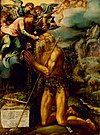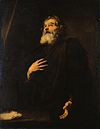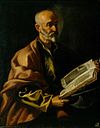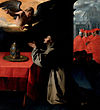List of Spanish paintings in the Gemäldegalerie Alte Meister Dresden
The Gemäldegalerie Alte Meister in Dresden has the most important collection of Spanish painting in Germany with 34 paintings . Although the collections of Spanish paintings in the Berlin Gemäldegalerie and the Alte Pinakothek in Munich are quantitatively somewhat larger, the Dresden collection is the only German one in which all the great Spanish Baroque painters are represented with important works. The collection began in 1666, when four landscape paintings by Pedro Orrente came into the electoral art collection. In the 18th century, three works by Diego Rodríguez de Silva y Velázquez were added. The most significant step in the history of the collection was the acquisition of 16 paintings from the espagnole gallery of the abdicated French king Louis-Philippe I at an auction in London in 1853.
The holdings of the Gemäldegalerie Alte Meister include the painting The Healing of the Blind, El Greco's only documented work in a German museum. Velázquez is represented with three works, while the Louvre in Paris or the Uffizi in Florence , for example, have no confirmed work by him. In addition to these outstanding examples, Spanish painting in Dresden is regionally balanced and of high quality. In addition to the Seville School , baroque painting from Madrid is present with Vicente Carducho and Valencia with Jerónimo de Espinosa . The Dresden holdings were worked on intensively by the important German art historians Carl Justi and August Liebmann Mayer , who worked in the field of Spanish art history . In 2012 Matthias Less presented the current inventory catalog, in the course of which all paintings were scientifically examined in detail.
Collection history
Beginning of the collection
The beginning of the collection of Spanish painting marks the arrival of four landscape paintings by Pedro Orrente in the electoral Art Collection on March 27, 1666. These were the mother of a prince from Portugal - perhaps Luisa of Guzman , mother of the Portuguese king . Peter II , - by presented to the envoy Lorenzo Astrapheli as a gift from the Dresden Kunstkammer. The exact circumstances of this donation are not known, but they could have reached Saxony as diplomatic gifts, for example in the context of marriage policy. August the Strong knew Spanish art from his own point of view. During his cavalier tour in 1687 and 1688, he stayed in Madrid and visited the surrounding royal residences El Pardo , El Retiro and El Escorial as well as the Palace of Aranjuez with its art collections. A large group of portraits of members of the Spanish court came to Saxony through diplomatic and family ties. However, these are not included in the gallery, but mostly only to be found in the sources.
With 16 paintings, almost half of the current holdings were already part of the electoral collection before the outbreak of the Seven Years' War . With nine works, paintings by and after Jusepe de Ribera formed the largest group within this collection, which were shown in the context of Italian painting until the 19th century. Most of them were already in the collection before the gallery in the Stallhof opened in the 1740s. For the Dresden collection, mainly pictures of cheerful and harmonious quality were acquired, which is why the artist's martyrdom scenes were not included in the collection and instead works from his circle that met these quality requirements were preferred. The second largest group within the early collection were the three works by Diego Rodríguez de Silva y Velázquez . These came to Dresden from the Galeria der Este in Modena , from which the 100 best paintings were acquired for the elector's possession. However, only one of these paintings was correctly attributed to Velázquez; the other two were considered works by Peter Paul Rubens at the time of purchase .
El Greco's The Healing of the Blind entered the collection as a Venetian work in 1741. This points to a general pattern in collecting activity that did not aim to acquire Spanish works of art. Count Hans Moritz von Brühl, for example, encouraged the Saxon legation secretary Louis Talon in Madrid to purchase Italian paintings in 1743. When he also sent Spanish paintings to Saxony, these purchases were criticized. Talon was not very reliable, acquired a large number of copies and doubtfully attributed works, and worked with the seedy Diego de Molina , from whom he purchased the majority of the 147 works. Since the works acquired by Talon are either lost or can no longer be identified, the critical position of the court towards them can no longer be traced and verified today. So it could be that, instead of doubts about the quality, a general lack of understanding for Spanish painting at that time could have justified the rejection of the acquired works by Spanish artists. The only work by a Spanish artist that was purposely acquired for the electoral collection was Bartolomé Esteban Murillos Maria with Child in 1755. Murillo was the only Spanish artist at that time who was also popular with collectors outside of Spain. In the middle of the 18th century, the Dresden gallery owned one of the most important collections of Spanish painting in Germany with the works of El Greco, Morales, Murillo, Ribera and Velázquez, although most of these paintings were not perceived in this context. Ribera's paintings in particular were featured prominently in the collection.
Plans for expansion in the first half of the 19th century
In 1817, the general director of the Gemäldegalerie Friedrich Matthäi arranged the Spanish works in the collection together in a separate room for the first time. The works of Ribera remained separate from these, but were also shown as a closed group. Overall, the people responsible increased their interest in Spanish art. As early as 1825, Matthäi and the professor at the Dresden Academy Ferdinand Hartmann planned to acquire further Spanish paintings for the collection. They made a list of works to be acquired, based on Johann Dominik Fiorillo's fourth volume of the history of the arts and sciences , published in 1806 , which dealt with Spanish painting. However, these plans could not be implemented at the time. At that time, Spanish art was still little known in Germany and it was only slowly becoming the focus of international attention: For example, Tsar Alexander I acquired several Spanish paintings in Amsterdam in 1814, and in 1838 the gallery espagnole was opened in the Musée Royal of the French King Louis- Philippe I set up in Paris . In Germany, a decisive impulse came from Johann Gottlob von Quandt , who also dealt with the art there in his travel descriptions in Spain published in 1850. In his book, he also criticized the fact that German museums contained paintings by Spanish artists of poor quality. As a member of the Saxon Art Association and the gallery commission, Quandt's position had weight for the Dresden gallery.
The acquisition of 1853
The year 1853 marked the most important acquisition in the history of the collection. The more than 400 paintings from the Galerie espagnole and around 250 other works from the Musée Standish owned by Louis-Philippe I were auctioned in London after the collection had been awarded to the king when he abdicated and had been allowed to be moved abroad. The director of the Dresden Kupferstichkabinett Ludwig Gruner bought 16 of these paintings for the Dresden Gemäldegalerie. Against the competition from the London National Gallery and other museums, Gruner managed to secure high-quality works. With the prayer of Saint Bonaventure for the election of the new Pope by Francisco de Zurbarán, he acquired the best of the almost 80 paintings from the collection that were ascribed to him. Gruner bought twelve of the paintings directly at auction, and after approval he acquired four more on June 29, 1853 through intermediaries. Gruner was free to choose which works to buy for the gallery. He showed a good knowledge of Spanish art because, in contrast to other acquisitions from the gallery espagnole, only a few attributions of the Dresden works were ultimately untenable. The more precise background of this large-scale acquisition could not be reconstructed from the sources known to date. The purchase seems surprising , especially due to the indifference of the gallery director Julius Schnorr von Carolsfeld towards Spanish painting and the deeply rooted anti-Catholicism in Saxony.
The material traces of the gallery espagnole have been preserved almost throughout the holdings of the Dresden Gemäldegalerie . Most of the paintings are still on the stretcher frames from 1837 and have the linings from that time. In addition, most of the works have numbers from the catalog from 1838 on the picture carriers, in some cases also the entry numbers of the Louvre and the auction numbers. In Dresden the paintings were given the gallery frame and were included in the catalog as early as 1853. This suggests that the works were already on display in the old gallery building, which closed in 1855.
Further development in the 19th century
The collection of Spanish painting was presented together with the Neapolitan School in Hall H of the new gallery building, in which the paintings by Peter Paul Rubens are now being shown. After the integration of the large bundle from London, the size of the Spanish collection in the Dresden Gemäldegalerie remained unchanged for a long time. In 1855 the purchase of further Murillo paintings was considered, but not considered urgent and not carried out. It was not until 1887 that another painting entered the collection of Spanish paintings: the manufacturer Richard Zschille gave the gallery a portrait of an officer from the Madrid school, which, however, was of little importance. Much more important was the acquisition of Murillos The Death of Saint Clare in 1894. This painting was in the possession of Alexandre Aguado in the 17th century and came to Dresden from an English private collection. The fact that Dresden was able to acquire this important work of one of the most popular Spanish painters is probably due to the great international attention Velázquez attracted at the time. The purchase was made possible by the art dealer Jean Paul Richter , who comes from Dresden and lives in London , who made the director Karl Woermann aware of the auction. The importance of this purchase is also clear from the fact that King Albert of Saxony personally took part in it.
The Spanish Collection in the 20th and 21st Centuries

At the beginning of the 20th century, the importance of the Spanish collection within the gallery decreased. After the Spaniersaal in Hall H was closed by Hans Posse in 1912 , it presented a core group with the works of Murillo and Velázques, the Zurbarán, Cano and Orrente as well as three works from the Ribera group in Hall C on the ground floor, which is now in its place a stairwell is located. After the newer masters were outsourced from the gallery , the Spanish paintings were shown on the second floor from 1925 without the Cano and the Orrente.
The inventory of Spanish paintings survived the Second World War largely unscathed. All important works were preserved, only two were lost. The crucifixion of Juan Correa de Vivar was destroyed in the air raid on the night of February 13-14, 1945 . The copy after Murillos The Little Fruit Merchant , the original of which can be found in the collection of the Alte Pinakothek , has been lost.
After the Second World War, the presentation of the Spanish works was upgraded by showing them in the three central room segments on the second floor since the reopening of the Old Masters Picture Gallery. The hanging has essentially survived to this day. In the 20th and 21st centuries, the Dresden gallery's collection of Spanish paintings grew only slowly. With the Resurrection of Christ by Juan Bautista Maíno from the estate of the Dresden art collector Friedrich Lahmann (1858–1937), one of the rare works by this artist came into the inventory in 1937. However, this work was probably never exhibited until 2003. The next acquisition did not follow until 2003: The Association of Friends of the Dresden State Art Collections acquired The Heads of the Martyrs Paulus, John the Baptist and James the Elder. Ä. from the school of Seville. In 2006, Juan de Arellano acquired a still life of flowers , which meant that a painter who was rarely present in German collections and an equally neglected genre of Spanish painting was added to the Dresden gallery. These additions to the holdings are valid throughout Germany, as other museums have barely expanded their Spanish holdings in recent decades.
The painting collection
Duration
| No. | image | Artist | title | Originated | Size, material | Acquisition, inventory number |
|---|---|---|---|---|---|---|
| 1 |

|
Juan de Arellano | Still life with flowers | around 1670/1675 | 85 × 105 cm, oil on canvas | 2006, Gal.-No. 2006/01 |
| 2 |

|
Alonso Cano | The apostle Paul | around 1650/1660 (?) | 212 × 111 cm, oil on canvas | 1853, Gal.-No. 702 |
| 3 |

|
Vicente Carducho | Saint Gonzalo between Saints Francis and Bernardine of Siena | 1630 | 220 × 164 cm, oil on canvas | 1853, Gal.-No. 681 |
| 4th |

|
Cordoba | Christ at the scourge column with repentant Peter | around 1510 | 177.5 × 75 cm, mixed media on chestnut wood | 1853, Gal.-No. 678 |
| 5 |

|
Jerónimo Jacinto de Espinosa | Saint Francis | around 1640/1650 | 91.5 × 91 cm, oil on canvas | 1853, Gal.-No. 700 |
| 6th |

|
Vicente Macip Comes | Mary's death | 1578/1583 | 121 × 127.5 cm, mixed media on pine | 1853, Gal.-No. 674 |
| 7th | School of Madrid | Portrait of an Officer | 2nd half of the 17th century | 61.5 × 49 cm, oil on canvas | 1887, Gal.-No. 703A | |
| 8th |

|
Juan Bautista Maíno | Resurrection of Christ | around 1610/1615 | 34.5 × 28 cm, oil on copper | 1937, Gal.-No. 2666 |
| 9 |

|
Luis de Morales | Ecce Homo | around 1510/1516 | 32.5 × 25 cm, oil on oak | 1744, Gal.-No. 673 |
| 10 |
|
Bartolomé Esteban Murillo | The death of Saint Clare | around 1645/46 | 190 × 446 cm, oil on canvas | 1894, Gal.-No. 703B |
| 11 |

|
Bartolomé Esteban Murillo | Saint Rodrigo | around 1650/1655 | 205 × 123 cm, oil on canvas | 1853, Gal.-No. 704 |
| 12 |

|
Bartolomé Esteban Murillo | Mary with child | around 1670/1680 | 166 × 115 cm, oil on canvas | 1755, Gal.-No. 705 |
| 13 |

|
Vasco Pereyra | Communion of Saint Onuphrius | 1583 | 109 × 81.5 cm, mixed media on oak | 1853, Gal.-No. 675 |
| 14th |

|
Jusepe de Ribera | Martyrdom of Saint Lawrence | around 1625 | 206 × 154 cm, oil on canvas | 1742, Gal.-No. 686 |
| 15th |

|
Jusepe de Ribera | Diogenes | 1637 | 76 × 61 cm, oil on canvas | 1722–1728, Gal. 682 |
| 16 |

|
Workshop of Jusepe de Ribera | Saint Francis on thorns | around 1640 (?) | 171.5 × 227.5 cm, oil on canvas | 1738/1757, Gal.-No. 685 |
| 17th |

|
Workshop of Jusepe de Ribera | The hermit Paul of Thebes | probably 1630/1640 | 205.5 × 151.5 cm, oil on canvas | 1746, Gal. 687 |
| 18th |

|
Successor to Jusepe de Ribera | Petri is freed from prison | Mid to second half of the 17th century | 174.5 × 226 cm, oil on canvas | 1738, Gal. 684 |
| 19th |

|
Jusepe de Ribera (student or imitator?) | Saint Agnes | 1641 (?) | 203 × 154 cm, oil on canvas | 1748 (?), Gal.-No. 683 |
| 20th |

|
Jusepe de Ribera or imitator (copy) | Saint Andrew | second half of the 17th century | 129 × 101 cm, oil on canvas | before 1753, Gal.-Nr. 688 |
| 21st |

|
Imitator (free copy?) Of Jusepe de Ribera | Lamentation of Christ | 18th century (?) | 155 × 220 cm, oil on canvas | 1856, Gal.-No. 708 |
| 22nd |

|
Copy after Jusepe de Ribera | Jacob with Laban's sheep | 17th century | 174 × 219 cm, oil on canvas | before 1753, Gal.-Nr. 689 |
| 23 |

|
Seville School | The apostle Matthias | Early 17th century | 104 × 83 cm, oil on canvas | 1853, Gal.-No. 680 |
| 24 |

|
Seville School | The heads of the martyrs Paul, John the Baptist and James the Elder. Ä. | around 1660/1670 | 108 × 132 cm, oil on canvas | 2003, Gal.-No. 2003/01 |
| 25th |

|
School of Seville or Sebastián de Llanos y Valdés | Carrying the Cross (after Jan van der Hoecke) | second half of the 17th century | 188 × 144 cm, oil on canvas | 1853, Gal.-No. 1047A |
| 26th |

|
Spanish school | Portrait of a stranger | around 1630/1640 (?) | 76 × 63.5 cm, oil on canvas | before 1835, Gal.-No. 1864 |
| 27 | Spanish or School of Genoa (?) | Personification of faith | second half of the 17th century (?) | 132 × 167 cm, oil on canvas | before 1817, Gal.-No. 711 | |
| 28 |

|
El Greco | The healing of the blind man | around 1570 | 65.5 × 84 cm, mixed media on poplar wood | 1741, Gal.-No. 276 |
| 29 |

|
Juan de Valdés Leal | Saint Vasco of Portugal | around 1656/1658 | 249 × 127.5 cm, oil on canvas | 1853, Gal.-No. 707 |
| 30th |

|
Valencia, successor to Pedro Orrente and Jerónimo Jacinto de Espinosa | Jacob and Rachel at the well | Mid 17th century | 176 × 222 cm, oil on canvas | 1853, Gal.-No. 677 |
| 31 |

|
Diego Rodríguez de Silva y Velázquez | Portrait of Don Juan Mateos | shortly before 1634 | 109 × 90.5 cm, oil on canvas | 1745/1746, Gal.-No. 697 |
| 32 |

|
Diego Rodríguez de Silva y Velázquez | Portrait of a Knight of Christ (Francisco de Andrade Leitão?) | around 1640/1650 | 67 × 56 cm, oil on canvas | 1745/1746, Gal.-No. 698 |
| 33 |

|
Diego Rodríguez de Silva y Velázquez and workshop | Portrait of Gaspar de Guzmán, Conde-Duque de Olivares, Duke of San Lúcar | around 1635 | 92.5 × 74 cm, oil on canvas | 1745/1746, Gal.-No. 699 |
| 34 |

|
Francisco de Zurbarán | Prayer of Saint Bonaventure for the election of the new Pope | 1628/1629 | 239 × 222 cm, oil on canvas | 1853, Gal.-No. 696 |
losses
| No. | image | Artist | title | Originated | Size, material | Acquisition, inventory number |
|---|---|---|---|---|---|---|
| 1 |

|
Juan Correa de Vivar | crucifixion | around 1550/1560 | 86 × 73.5 cm, pine wood | 1853, Gal.-No. 679, loss of war (destroyed) |
| 2 | Bartolomé Esteban Murillo (copy) | The little fruit seller | 130 × 96 cm, canvas | 1830, Gal.-No. 706, missing since World War II |
Depreciation
literature
- Matthias Less: State Art Collections Dresden. Old Masters Picture Gallery. Inventory catalog Spanish painting. Prestel, Munich 2012, ISBN 978-3-7913-5179-7 .
- Heinz Spielmann and Ortrud Westheider (eds.): Greco, Velázquez, Goya. Spanish painting from German collections . Prestel, Munich 2005, ISBN 3-7913-3412-3 .
Individual evidence
- ^ Matthias Less, Introduction, in: Matthias Less: Staatliche Kunstsammlungen Dresden. Old Masters Picture Gallery. Inventory catalog Spanish painting. Prestel, Munich 2012, pp. 14–31, 14.
- ^ A b Matthias Less, Introduction, in: Matthias Less: Staatliche Kunstsammlungen Dresden. Old Masters Picture Gallery. Inventory catalog Spanish painting. Prestel, Munich 2012, pp. 14–31, 14 and 15.
- ↑ a b c Matthias Less, Introduction, in: Matthias Less: Staatliche Kunstsammlungen Dresden. Old Masters Picture Gallery. Inventory catalog Spanish painting. Prestel, Munich 2012, pp. 14–31, 17.
- ^ A b Matthias Less, Introduction, in: Matthias Less: Staatliche Kunstsammlungen Dresden. Old Masters Picture Gallery. Inventory catalog Spanish painting. Prestel, Munich 2012, pp. 14–31, 18.
- ^ A b Matthias Less, Introduction, in: Matthias Less: Staatliche Kunstsammlungen Dresden. Old Masters Picture Gallery. Inventory catalog Spanish painting. Prestel, Munich 2012, pp. 14–31, 19.
- ^ Bernhard Maaz, Spanish painting in Germany and the Dresden inventory: Instead of a foreword, in: Matthias Less: Staatliche Kunstsammlungen Dresden. Old Masters Picture Gallery. Inventory catalog Spanish painting. Prestel, Munich 2012, pp. 6–11, 6.
- ^ A b c Bernhard Maaz, Spanish painting in Germany and the Dresden inventory: Instead of a foreword, in: Matthias Less: Staatliche Kunstsammlungen Dresden. Old Masters Picture Gallery. Inventory catalog Spanish painting. Prestel, Munich 2012, pp. 6–11, 7.
- ^ Bernhard Maaz, Spanish painting in Germany and the Dresden inventory: Instead of a foreword, in: Matthias Less: Staatliche Kunstsammlungen Dresden. Old Masters Picture Gallery. Inventory catalog Spanish painting. Prestel, Munich 2012, pp. 6–11, 9.
- ^ Matthias Less, Introduction, in: Matthias Less: Staatliche Kunstsammlungen Dresden. Old Masters Picture Gallery. Inventory catalog Spanish painting. Prestel, Munich 2012, pp. 14–31, 20.
- ^ Matthias Less, Introduction, in: Matthias Less: Staatliche Kunstsammlungen Dresden. Old Masters Picture Gallery. Inventory catalog Spanish painting. Prestel, Munich 2012, pp. 14–31, 21.
- ^ Matthias Less, Introduction, in: Matthias Less: Staatliche Kunstsammlungen Dresden. Old Masters Picture Gallery. Inventory catalog Spanish painting. Prestel, Munich 2012, pp. 14–31, 21 and 22.
- ^ A b Matthias Less, Introduction, in: Matthias Less: Staatliche Kunstsammlungen Dresden. Old Masters Picture Gallery. Inventory catalog Spanish painting. Prestel, Munich 2012, pp. 14–31, 22.
- ↑ a b c Matthias Less, Introduction, in: Matthias Less: Staatliche Kunstsammlungen Dresden. Old Masters Picture Gallery. Inventory catalog Spanish painting. Prestel, Munich 2012, pp. 14–31, 23.
- ↑ a b c Matthias Less, Introduction, in: Matthias Less: Staatliche Kunstsammlungen Dresden. Old Masters Picture Gallery. Inventory catalog Spanish painting. Prestel, Munich 2012, pp. 14–31, 24.
- ^ Matthias Less: State Art Collections Dresden. Old Masters Picture Gallery. Inventory catalog Spanish painting. Prestel, Munich 2012, p. 190.
